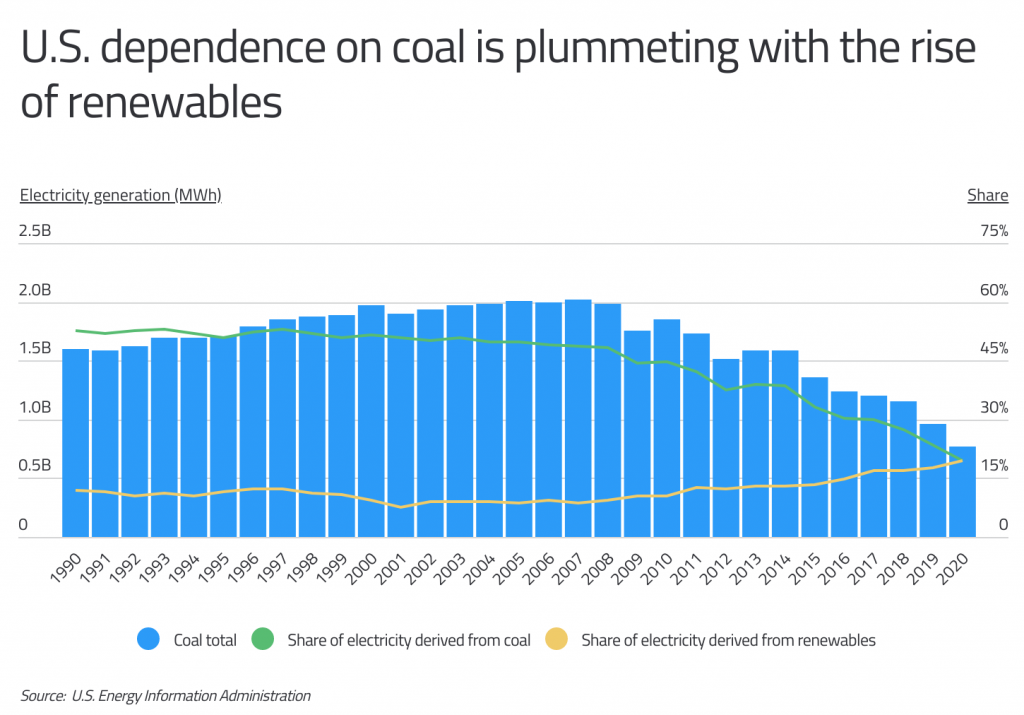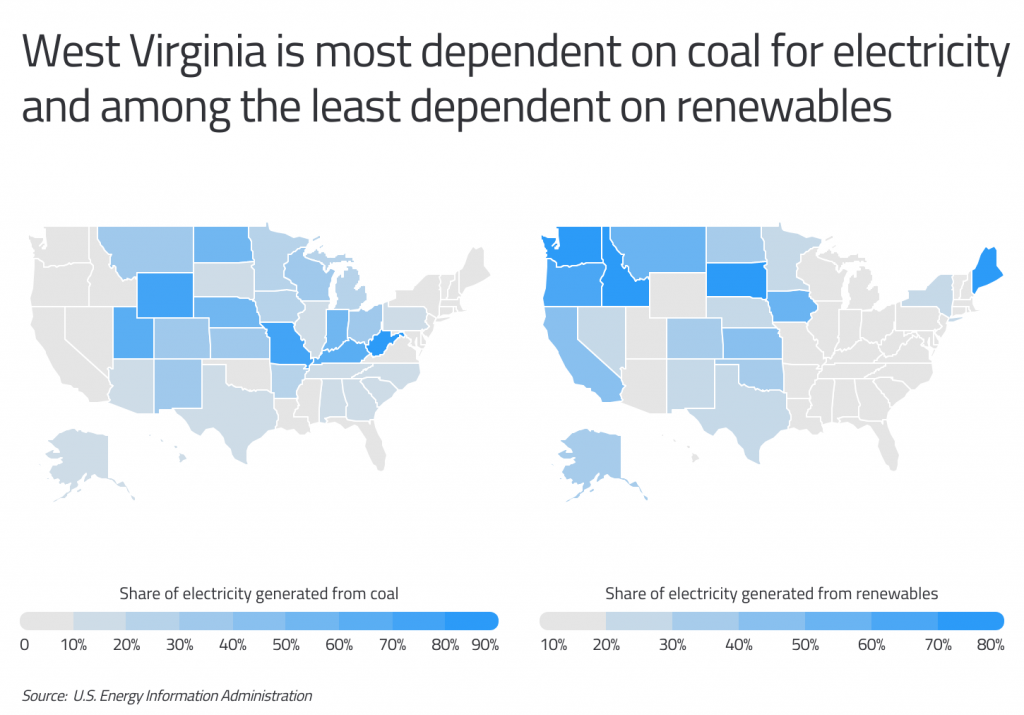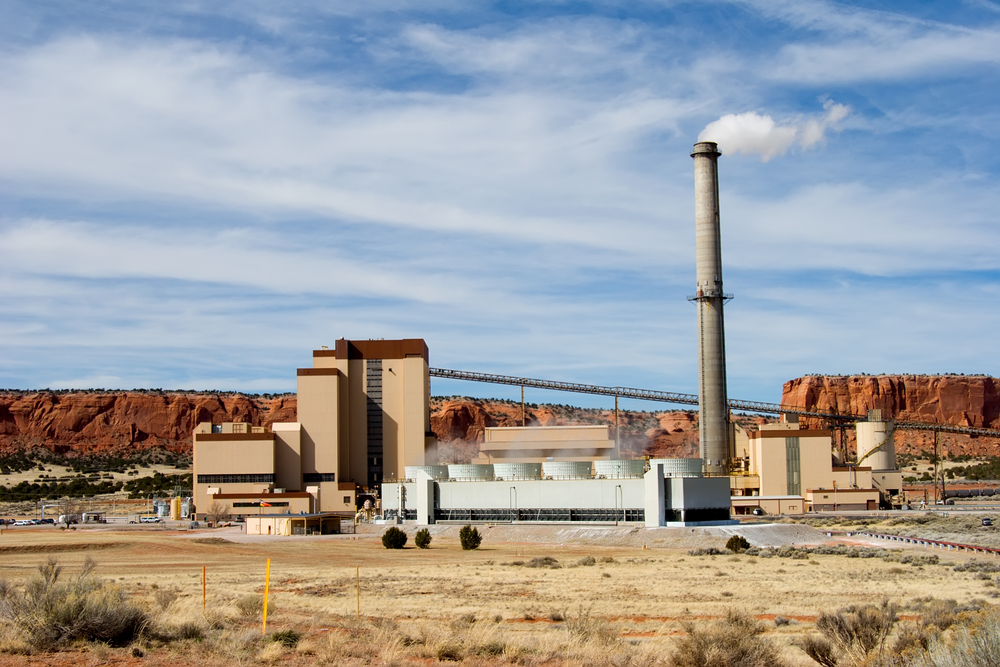
Photo Credit: I. Noyan Yilmaz / Shutterstock
At the recent UN Climate Change Conference in Glasgow, world leaders convened to negotiate new goals for reducing carbon emissions in the effort to slow the pace of global warming. Across two weeks of negotiations, one of the major issues under discussion was the use of coal as an energy source. Some coal-dependent nations including India and China argued for a “phase down” rather than a total “phase out” of coal power in the final agreement, while U.S. envoy John Kerry predicted in an interview that the U.S. would eliminate coal by 2030.
Coal is one of the cheapest energy sources available in the U.S., in part because the U.S. houses a large portion of the world’s coal reserves. But coal also has other environmental and social downsides that have made it a less desirable fuel source. Mining and burning coal heavily emits greenhouse gases like carbon dioxide and methane and also poses risks of air and water pollution. Many policymakers and environmental advocates are now pushing for a transition away from coal for that reason.
Until recently, however, cost won out, and inexpensive coal was the predominant fuel source in the U.S., accounting for more than half of electricity generation in the U.S. up until 2003. Since then, dependence on coal has plummeted and currently accounts for only 19.3% of total U.S. generation. The swift decline in coal has been made possible as other cleaner energy sources have become less expensive. Natural gas has seen a major boom over the last two decades as techniques like hydraulic fracturing and horizontal drilling made it easier to extract. Renewable sources like wind and solar have also become less expensive and more widely adopted in recent years thanks to government investment and technological advances. As a result, the share of electricity generated from renewables has risen by two-thirds since 1990.

Some states that have traditionally relied on coal both as an economic driver and as an energy source have been slower to make the transition. The majority of coal production in the U.S. is contained to a handful of states, including Wyoming and West Virginia, and because coal is cheap and plentiful, these heavy coal producers are also among the states that generate the greatest share of electricity from coal and a lower share from renewables. In contrast, the states that depend more heavily on renewables either have governments that have prioritized clean energy and emissions reductions or geographic features that make them well-suited to wind, solar, or hydropower installations.

The data used in this analysis is from the U.S. Energy Information Administration. To determine the states most dependent on coal for electricity, researchers at Commodity.com calculated the share of total electricity generated from coal. In the event of a tie, the state with the greater total electricity generated from coal was ranked higher. Researchers also calculated the total and proportion of electricity generated from renewable sources. Renewable sources include solar, wind, geothermal, biomass, and hydroelectric.
Here are the states most dependent on coal for electricity.
The Most Coal-Dependent States in the U.S.

Photo Credit: Jonathan C Wear / Shutterstock
15. Arkansas
- Share of electricity generated from coal: 28.2%
- 5-year change in electricity generated from coal: -29.1%
- Total electricity generated from coal (MWh): 15,420,998
- Share of electricity generated from renewables: 10.5%
- Total electricity generated from renewables (MWh): 5,735,702

Photo Credit: Arno Jenkins / Shutterstock
14. Kansas
- Share of electricity generated from coal: 31.1%
- 5-year change in electricity generated from coal: -31.0%
- Total electricity generated from coal (MWh): 16,959,839
- Share of electricity generated from renewables: 44.2%
- Total electricity generated from renewables (MWh): 24,117,519

Photo Credit: Joshua Schultz / Shutterstock
13. Colorado
- Share of electricity generated from coal: 36.0%
- 5-year change in electricity generated from coal: -38.2%
- Total electricity generated from coal (MWh): 19,478,405
- Share of electricity generated from renewables: 30.9%
- Total electricity generated from renewables (MWh): 16,724,964

Photo Credit: Robert Paulus / Shutterstock
12. Montana
- Share of electricity generated from coal: 36.4%
- 5-year change in electricity generated from coal: -47.0%
- Total electricity generated from coal (MWh): 8,490,284
- Share of electricity generated from renewables: 59.4%
- Total electricity generated from renewables (MWh): 13,872,119

Photo Credit: Corey B Stevens / Shutterstock
11. Ohio
- Share of electricity generated from coal: 37.2%
- 5-year change in electricity generated from coal: -37.2%
- Total electricity generated from coal (MWh): 45,008,596
- Share of electricity generated from renewables: 2.9%
- Total electricity generated from renewables (MWh): 3,500,737

Photo Credit: photoBeard / Shutterstock
10. New Mexico
- Share of electricity generated from coal: 37.5%
- 5-year change in electricity generated from coal: -37.4%
- Total electricity generated from coal (MWh): 12,788,184
- Share of electricity generated from renewables: 27.2%
- Total electricity generated from renewables (MWh): 9,253,738

Photo Credit: Ralf Broskvar / Shutterstock
9. Wisconsin
- Share of electricity generated from coal: 38.7%
- 5-year change in electricity generated from coal: -36.1%
- Total electricity generated from coal (MWh): 23,761,097
- Share of electricity generated from renewables: 9.4%
- Total electricity generated from renewables (MWh): 5,779,793

Photo Credit: marekuliasz / Shutterstock
8. Nebraska
- Share of electricity generated from coal: 51.0%
- 5-year change in electricity generated from coal: -22.3%
- Total electricity generated from coal (MWh): 18,788,647
- Share of electricity generated from renewables: 28.9%
- Total electricity generated from renewables (MWh): 10,648,740

Photo Credit: Amy Nichole Harris / Shutterstock
7. Indiana
- Share of electricity generated from coal: 53.1%
- 5-year change in electricity generated from coal: -38.9%
- Total electricity generated from coal (MWh): 47,772,885
- Share of electricity generated from renewables: 8.2%
- Total electricity generated from renewables (MWh): 7,364,544

Photo Credit: David Gaylor / Shutterstock
6. North Dakota
- Share of electricity generated from coal: 58.1%
- 5-year change in electricity generated from coal: -11.7%
- Total electricity generated from coal (MWh): 24,496,807
- Share of electricity generated from renewables: 38.1%
- Total electricity generated from renewables (MWh): 16,084,768

Photo Credit: Gary Whitton / Shutterstock
5. Utah
- Share of electricity generated from coal: 61.5%
- 5-year change in electricity generated from coal: -28.0%
- Total electricity generated from coal (MWh): 22,806,021
- Share of electricity generated from renewables: 12.5%
- Total electricity generated from renewables (MWh): 4,644,687

Photo Credit: The American Wanderer / Shutterstock
4. Kentucky
- Share of electricity generated from coal: 68.7%
- 5-year change in electricity generated from coal: -39.9%
- Total electricity generated from coal (MWh): 43,638,313
- Share of electricity generated from renewables: 8.5%
- Total electricity generated from renewables (MWh): 5,395,636

Photo Credit: Joseph Sohm / Shutterstock
3. Missouri
- Share of electricity generated from coal: 71.3%
- 5-year change in electricity generated from coal: -20.8%
- Total electricity generated from coal (MWh): 51,755,690
- Share of electricity generated from renewables: 7.5%
- Total electricity generated from renewables (MWh): 5,450,572

Photo Credit: Jim Parkin / Shutterstock
2. Wyoming
- Share of electricity generated from coal: 79.4%
- 5-year change in electricity generated from coal: -22.6%
- Total electricity generated from coal (MWh): 33,359,104
- Share of electricity generated from renewables: 16.1%
- Total electricity generated from renewables (MWh): 6,763,997

Photo Credit: Kristi Blokhin / Shutterstock
1. West Virginia
- Share of electricity generated from coal: 88.6%
- 5-year change in electricity generated from coal: -26.2%
- Total electricity generated from coal (MWh): 50,216,398
- Share of electricity generated from renewables: 6.2%
- Total electricity generated from renewables (MWh): 3,496,285
Detailed Findings & Methodology
The data used in this analysis is from the U.S. Energy Information Administration’s Electricity Power Data. To determine the states most dependent on coal for electricity, researchers calculated the share of total electricity generated from coal. Only states with complete data available are included in the analysis. In the event of a tie, the state with the greater total electricity generated from coal was ranked higher. Researchers also calculated the total and proportion of electricity generated from renewable sources. Renewable sources include solar, wind, geothermal, biomass, and hydroelectric.